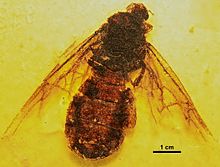Titanomyrma
|
Titanomyrma Temporal range: 49.5 Ma |
|
|---|---|
 |
|
| Dorsal view of Titanomyrma gigantea holotype, specimen SMFMEI00998 | |
| Scientific classification | |
| Kingdom: | Animalia |
| Phylum: | Arthropoda |
| Class: | Insecta |
| Order: | Hymenoptera |
| Family: | Formicidae |
| Subfamily: | Formiciinae |
| Genus: |
Titanomyrma Archibald et al., 2011 |
| Species | |
|
|
Titanomyrma is a genus of prehistoric giant ant. The latest species to be discovered, T. lubei, was described in 2011, when a 49.5 million year old fossilized winged queen ant, comparable in size to hummingbirds, was found in Wyoming. This fossil is the first fossil of a giant ant found in the Western Hemisphere. The presence of Titanomyrma in North America is considered to indicate "the first reported cross-Arctic dispersal by a thermophilic insect group". Another fossil species of this genus, T. gigantea, is the largest known fossil or extant species of giant ant in the world.
The fossil ant Titanomyrma lubei was discovered in ancient lake sediments in the DMNS locality 784, Farson Fish Beds, Laney Member of the Green River Formation; Sweetwater County, Wyoming, USA by Louis Lube, the collector and donor of the holotype specimen.
The fossil is part of the collection of Denver Museum of Nature and Science and was discovered by Bruce Archibald and co-author and museum chief curator Kirk R. Johnson while casually going through storage drawers. The fossil depicts the queen ant only and no fossils of workers have been found. With the discovery of Titanomyrma lubei and the description of the genus, two other species of giant ants, Formicium gigantea and Formicium simillima, were reclassified into this genus.
Well preserved fossils of Titanomyrma giganteum and Titanomyrma simillima were discovered in the Messel shales, near the village of Messel, in the state of Hesse, 30 km south of Frankfurt am Main (Darmstadt Administrative District), in Germany. A related undescribed species has been found in the nearby Eckfeld Maar.
...
Wikipedia
